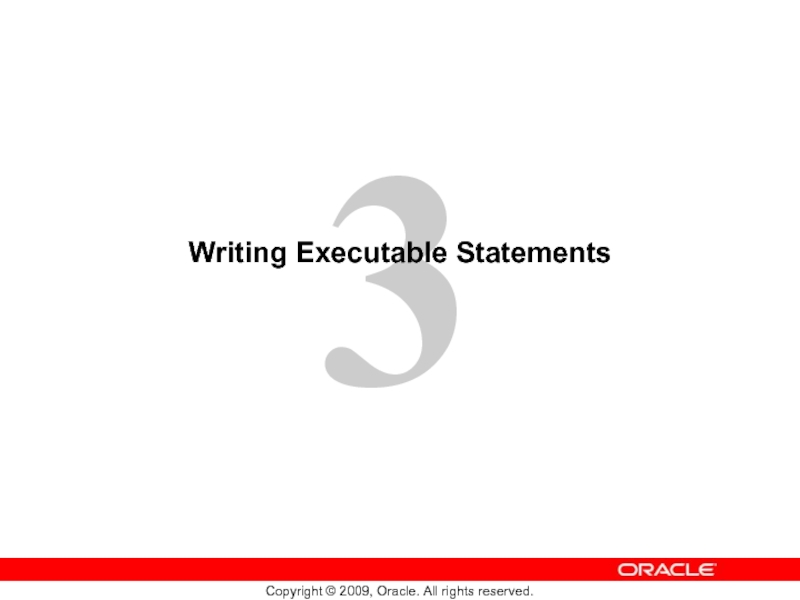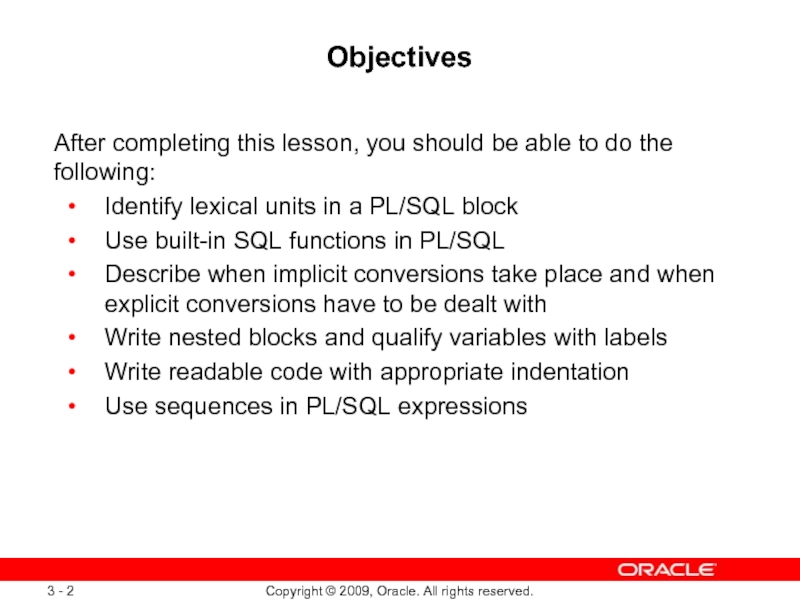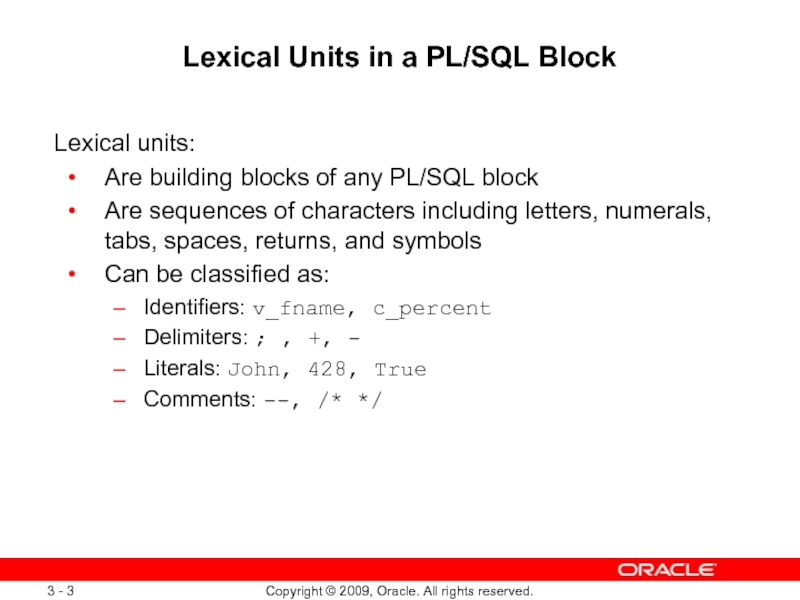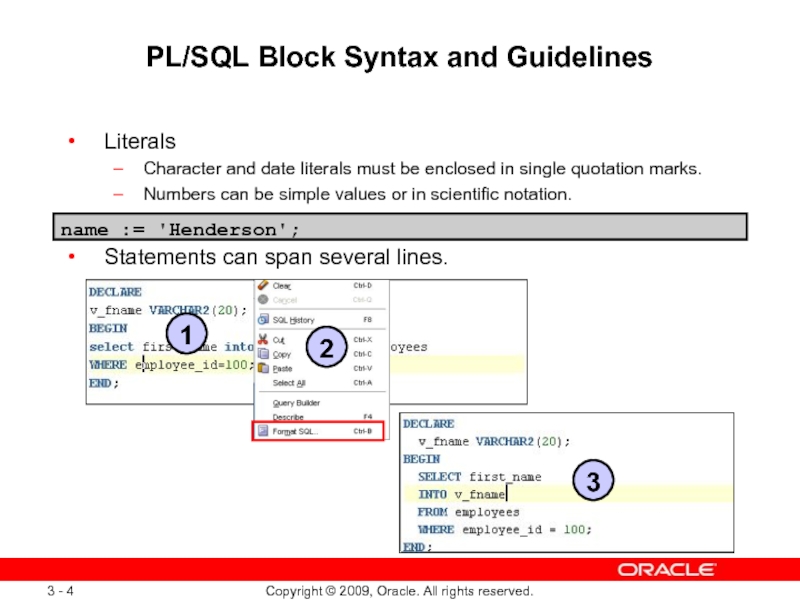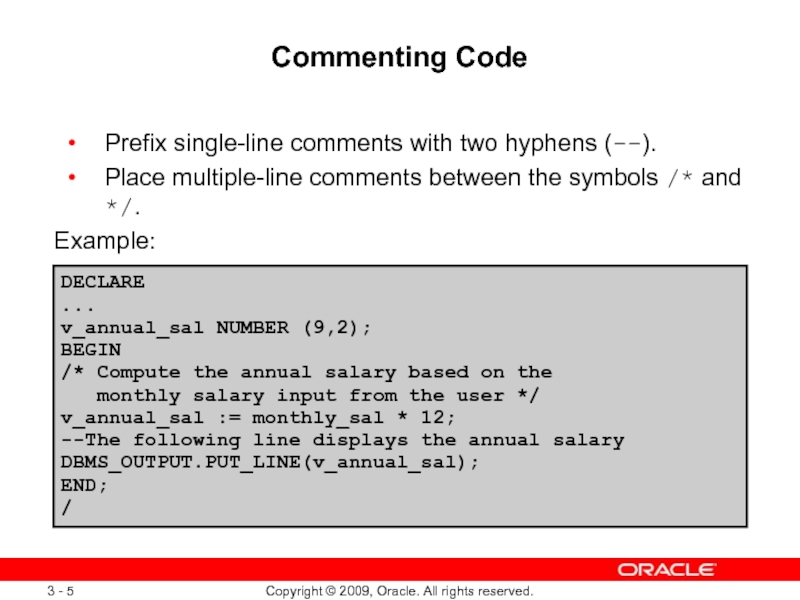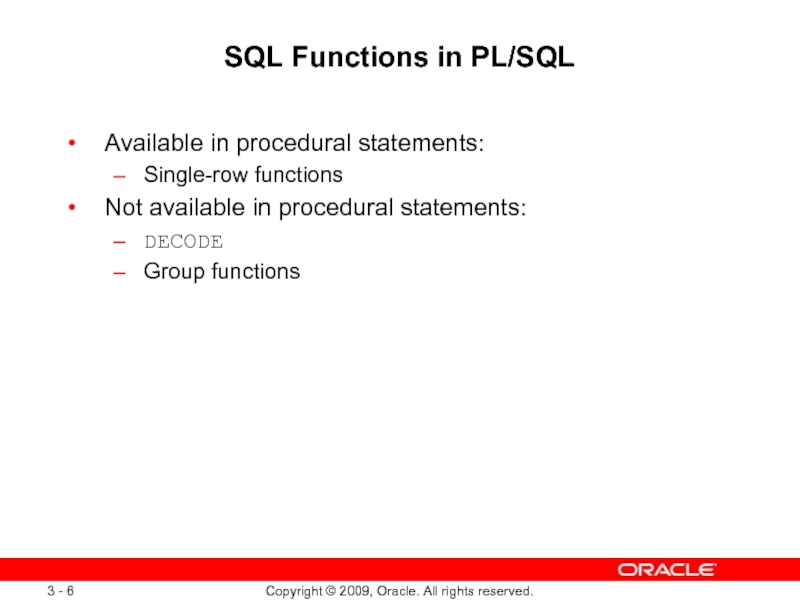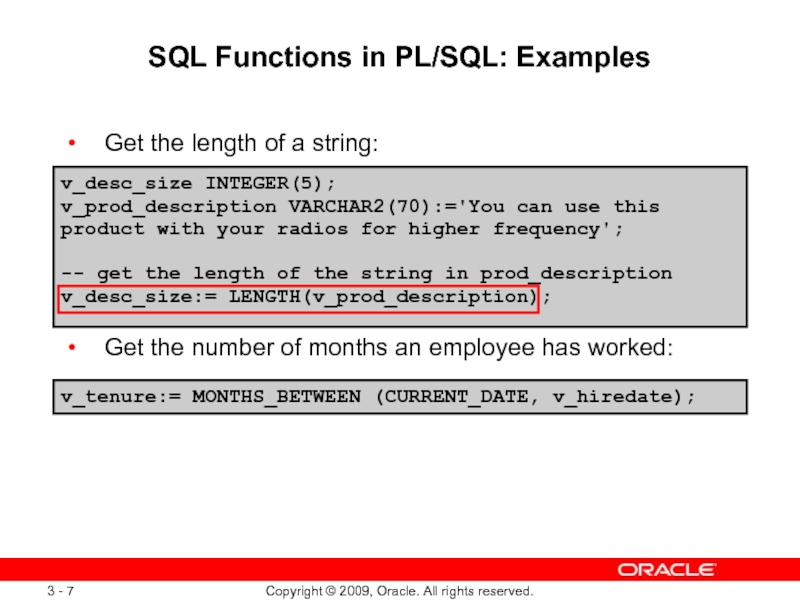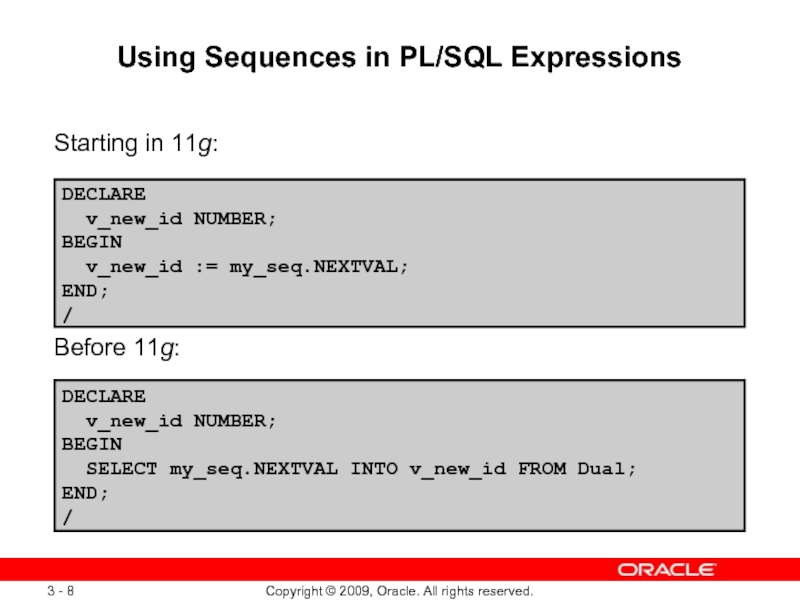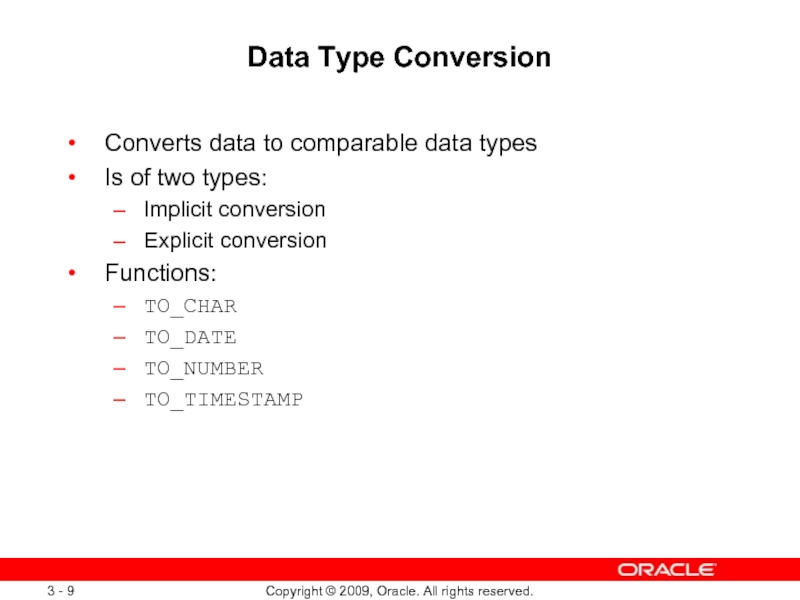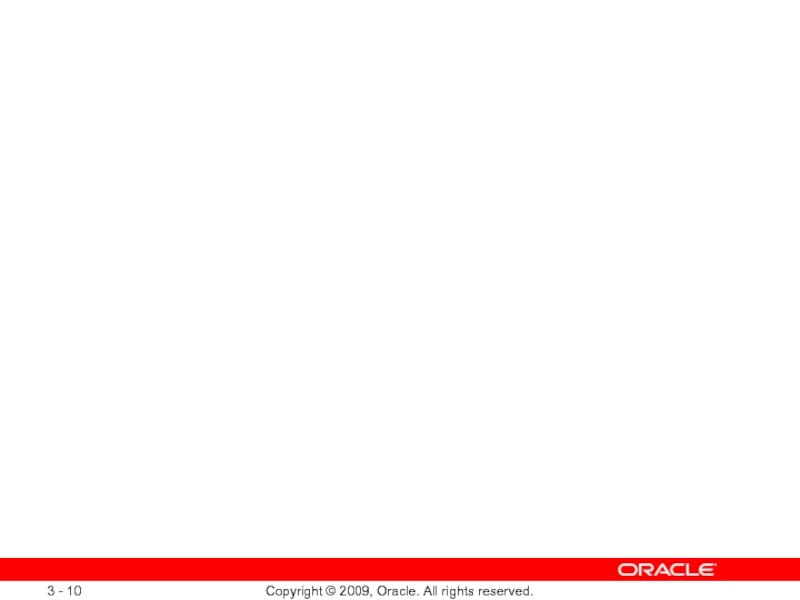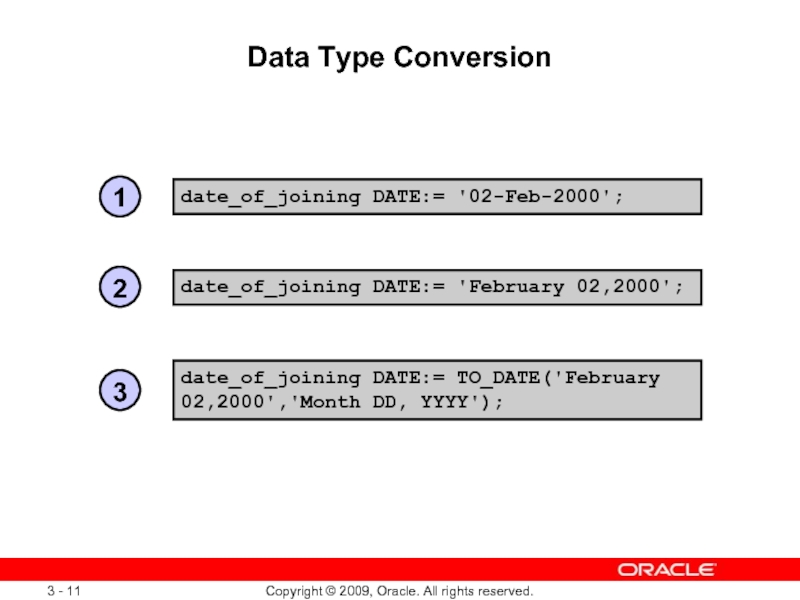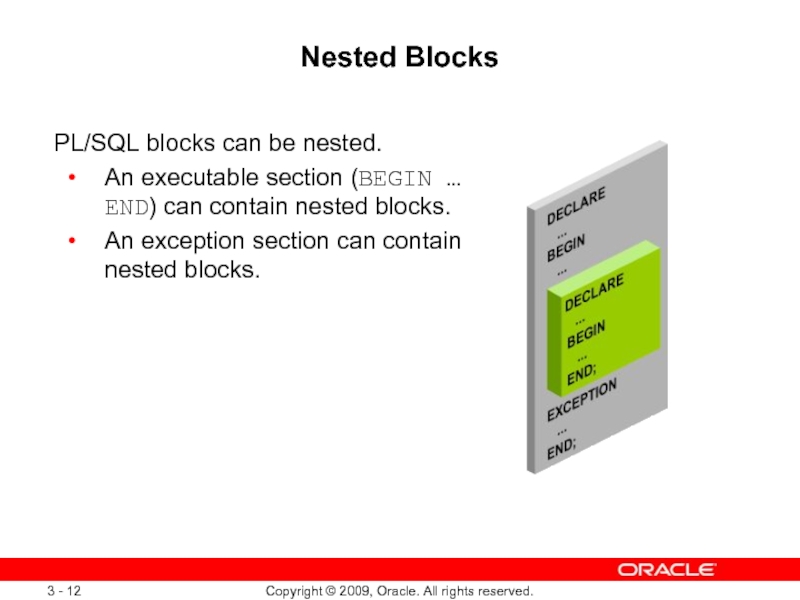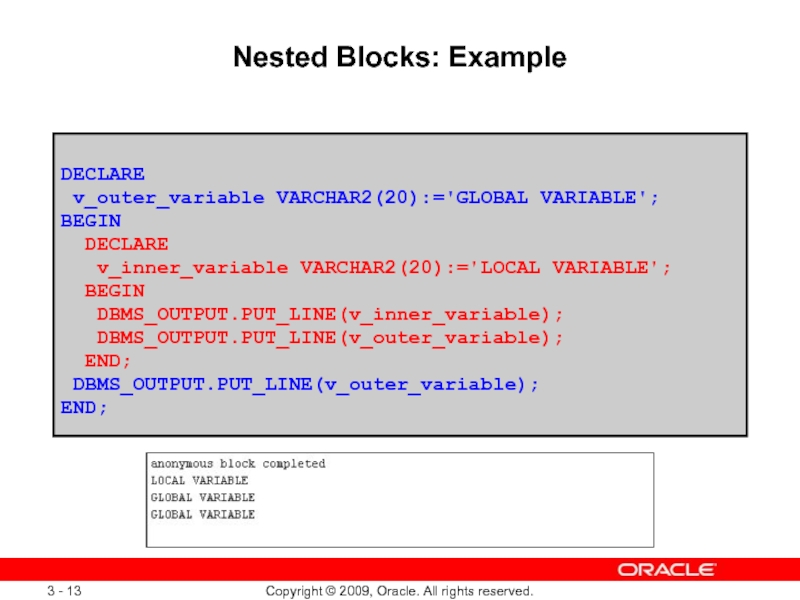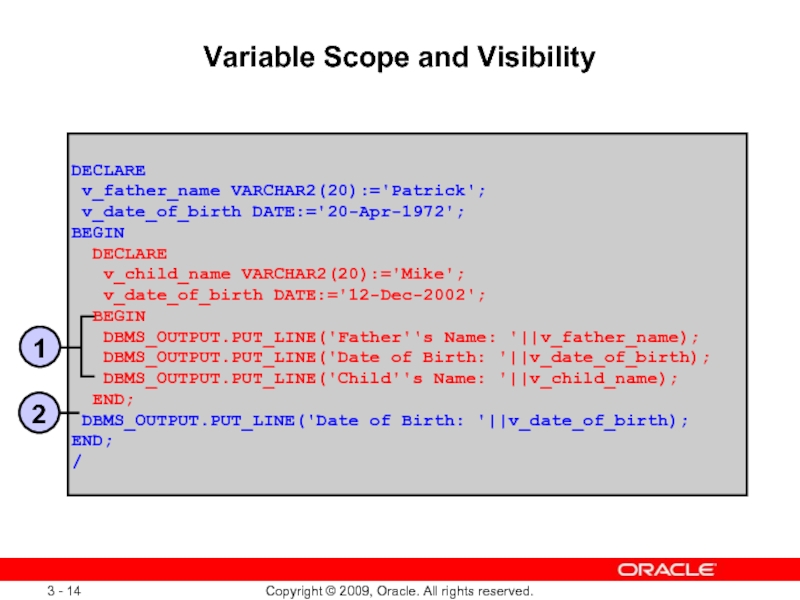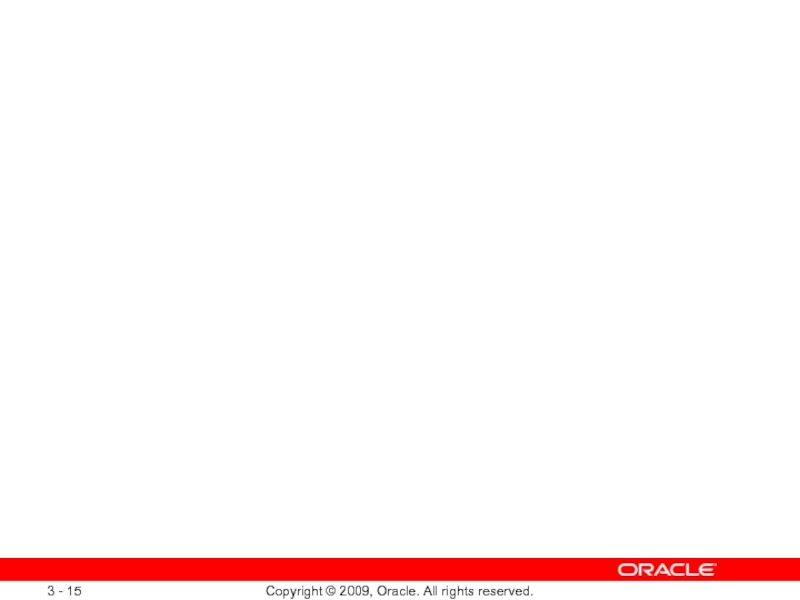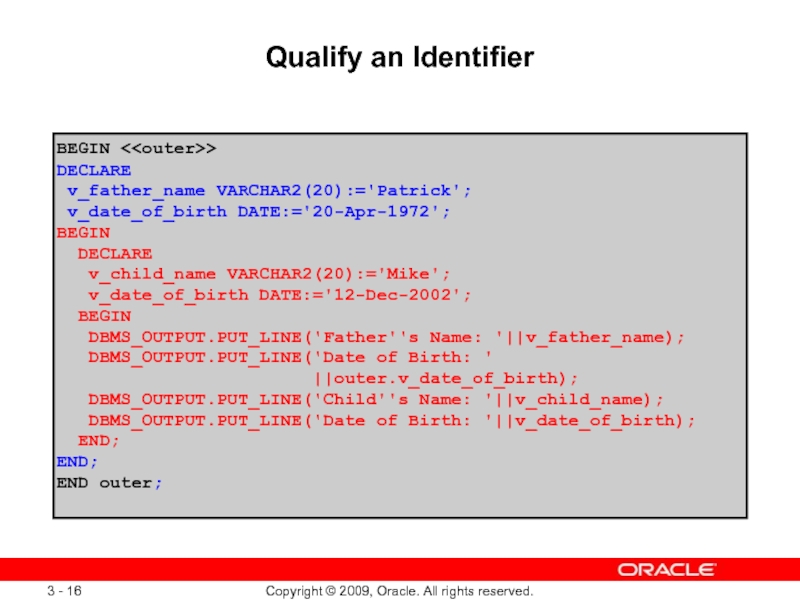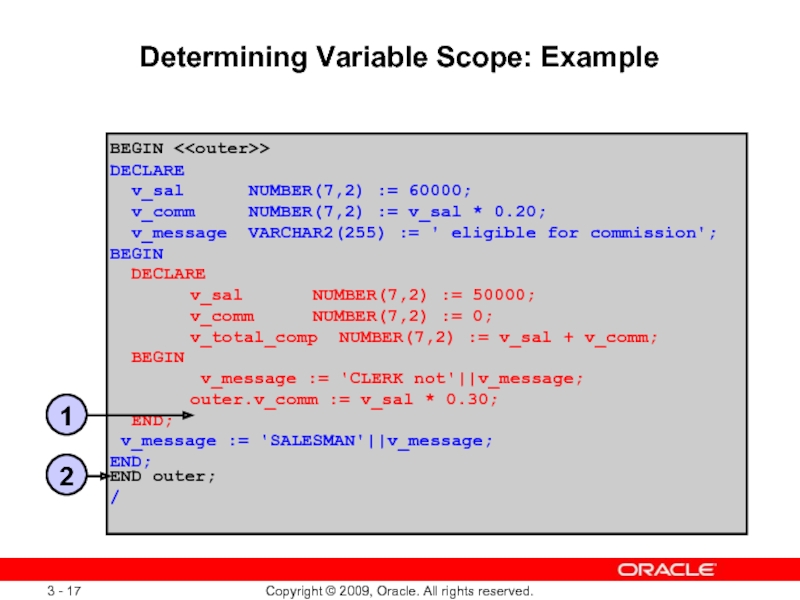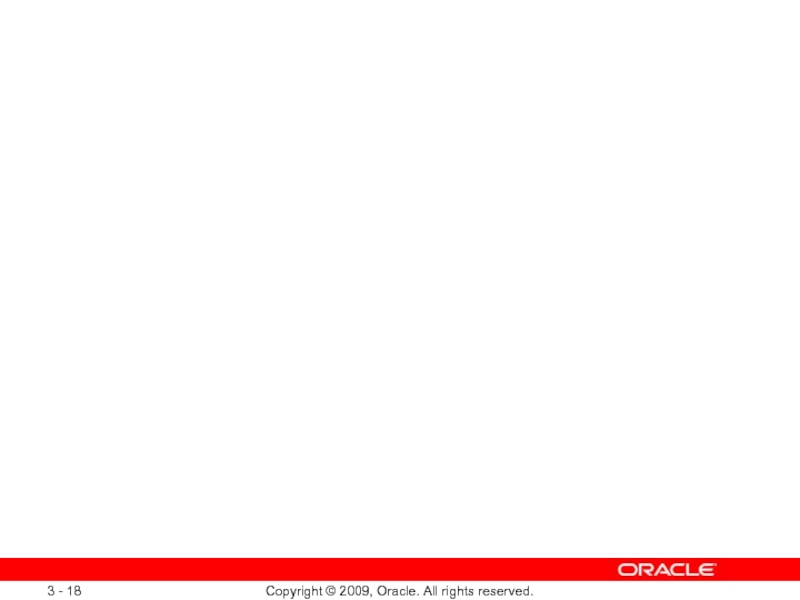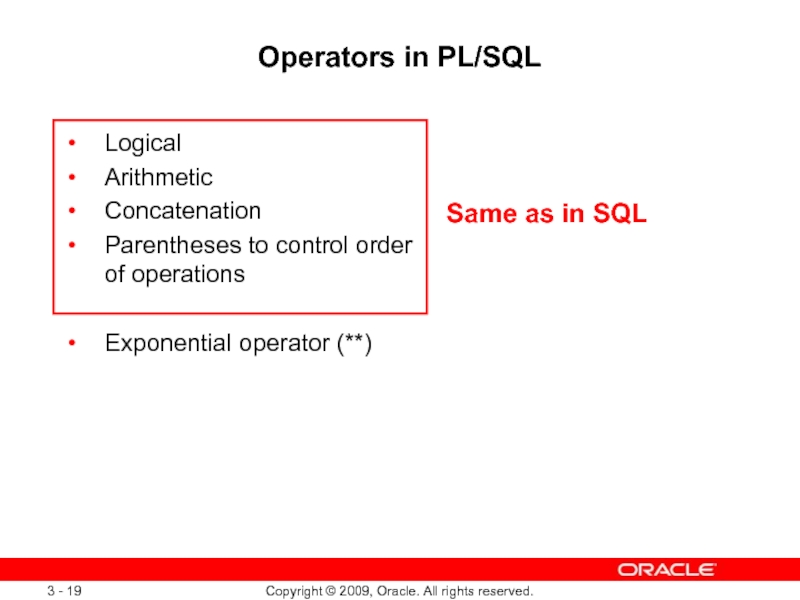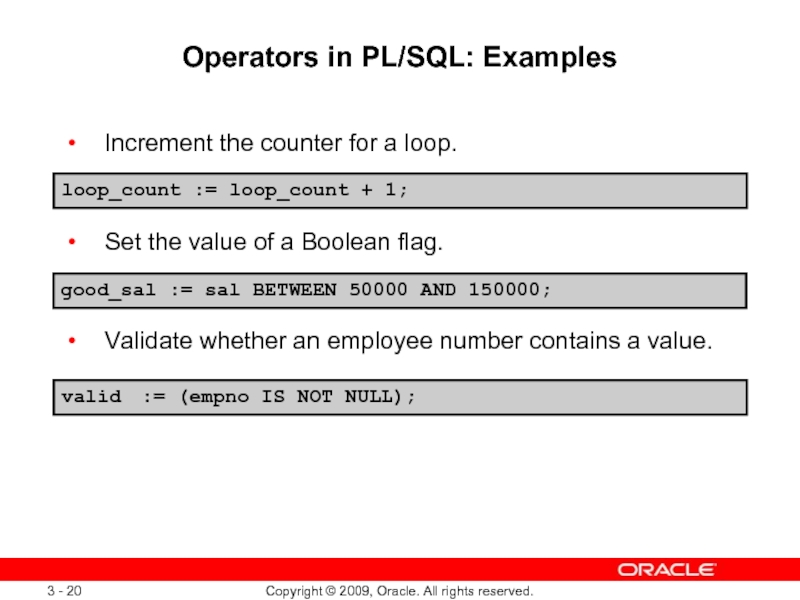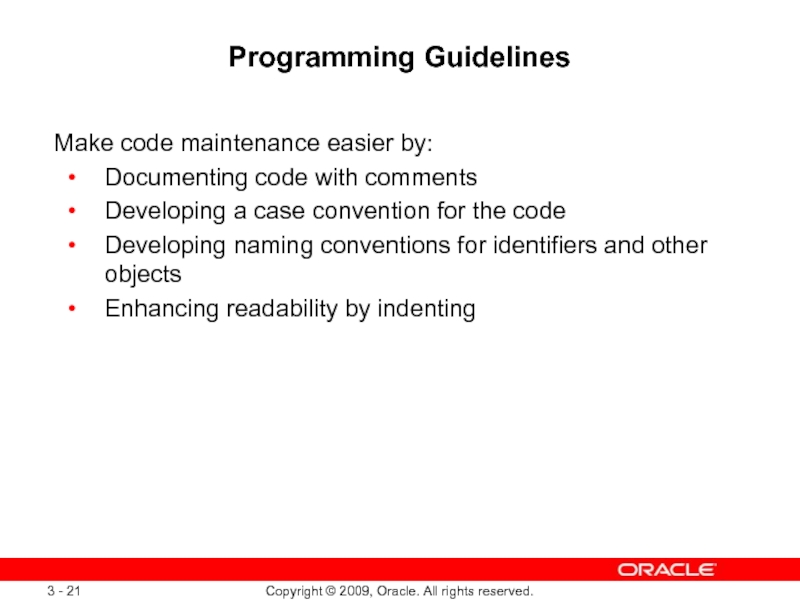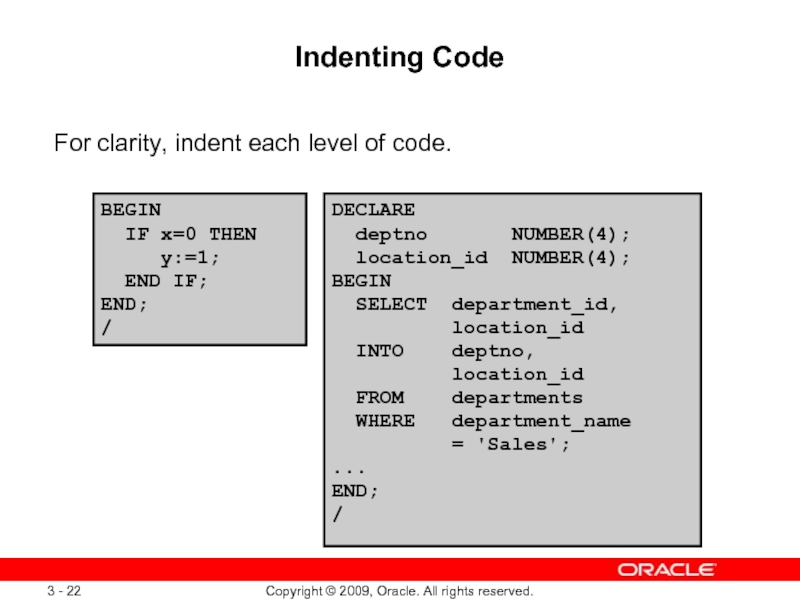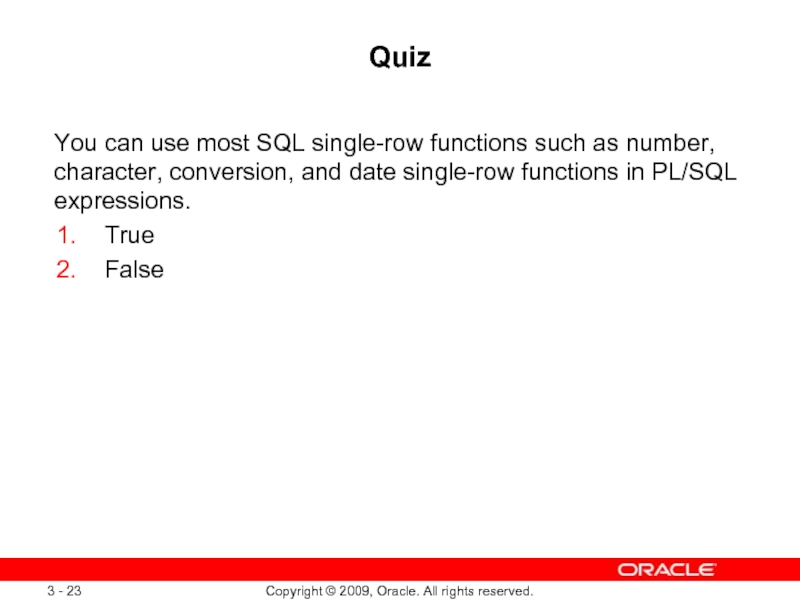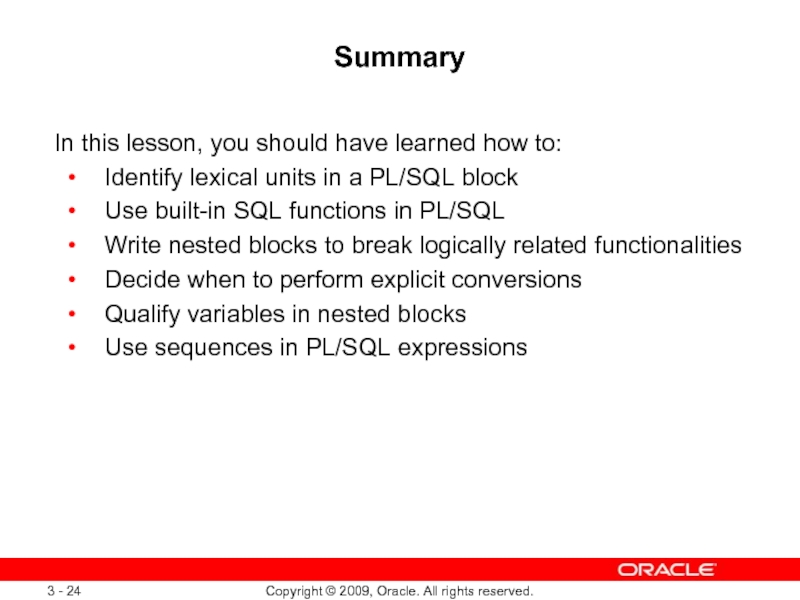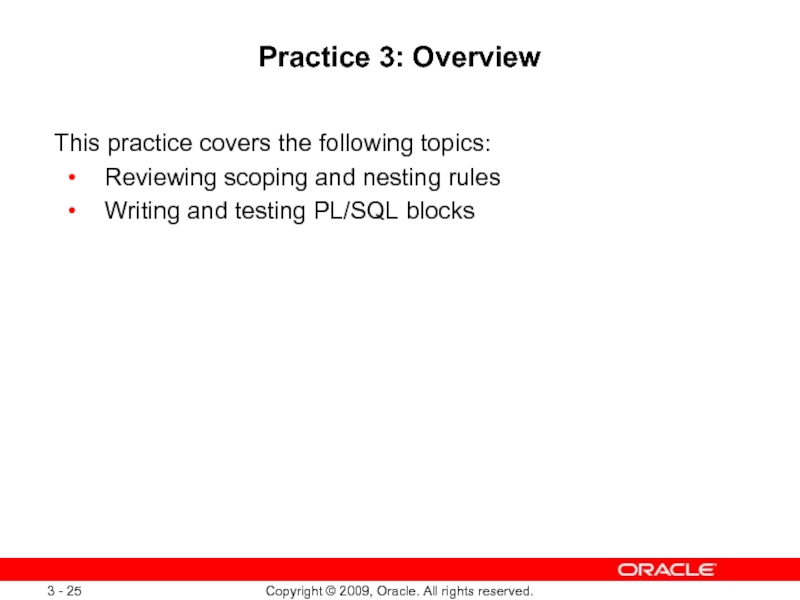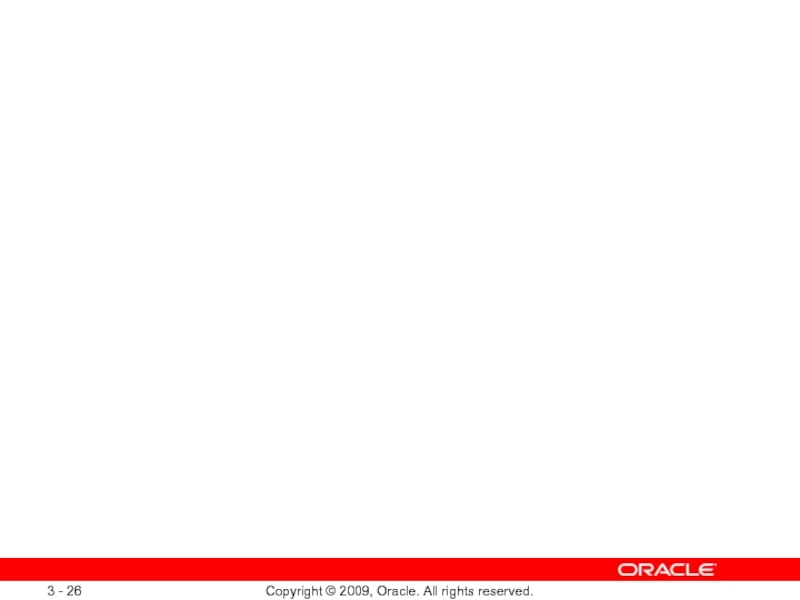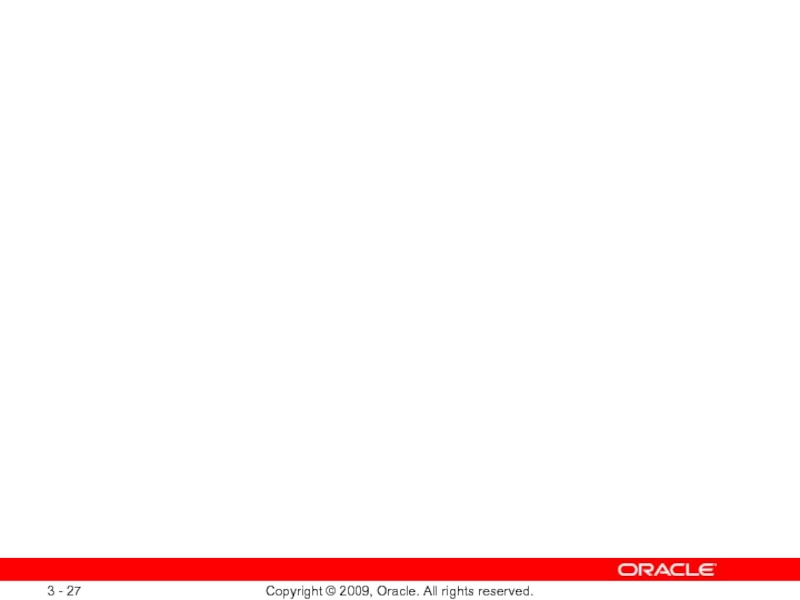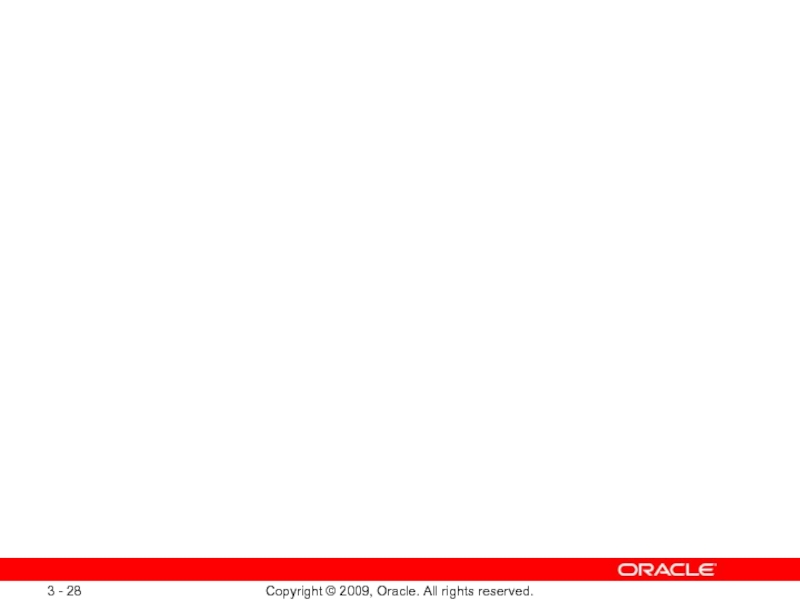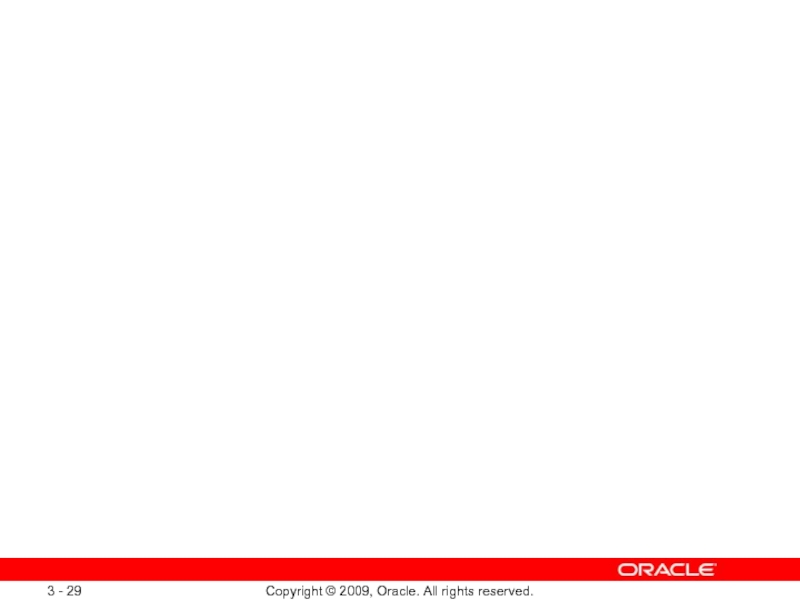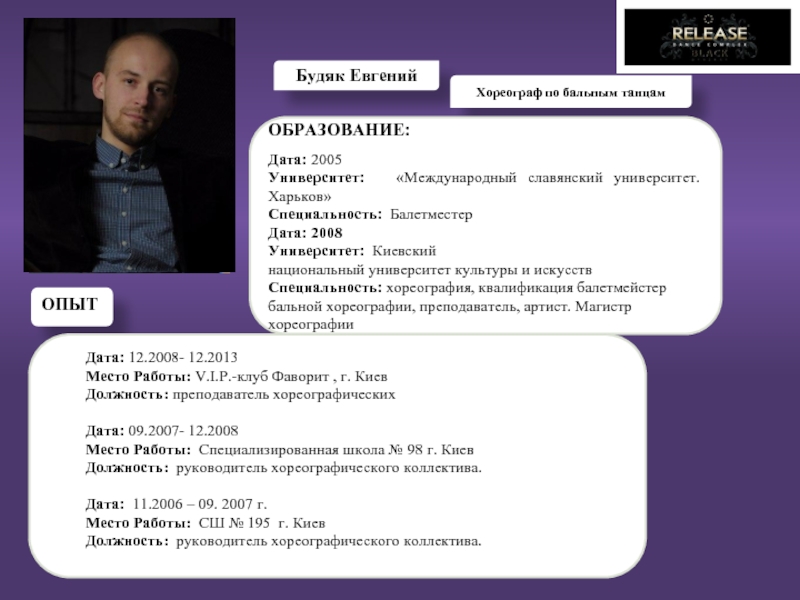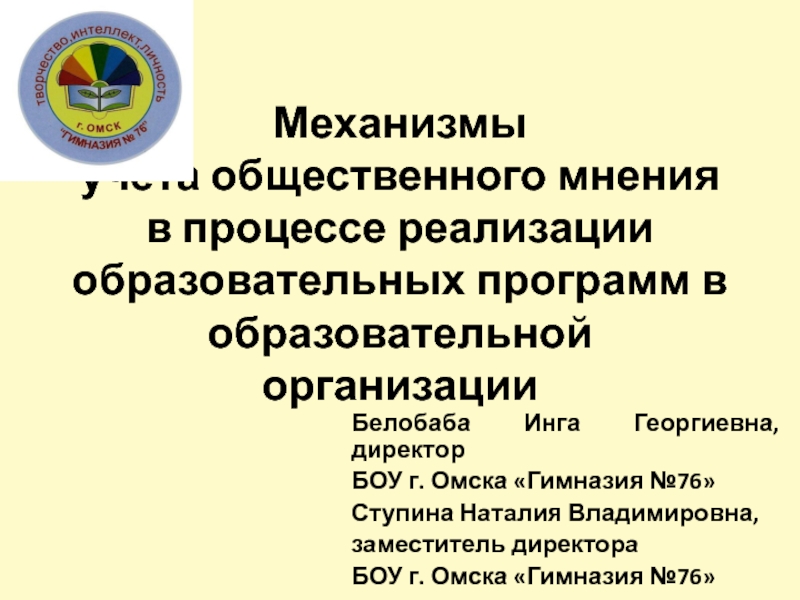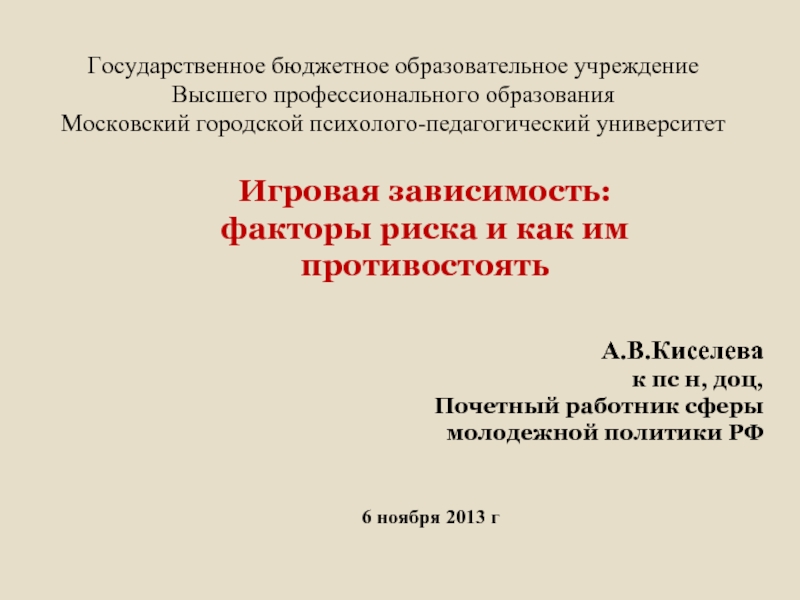- Главная
- Разное
- Дизайн
- Бизнес и предпринимательство
- Аналитика
- Образование
- Развлечения
- Красота и здоровье
- Финансы
- Государство
- Путешествия
- Спорт
- Недвижимость
- Армия
- Графика
- Культурология
- Еда и кулинария
- Лингвистика
- Английский язык
- Астрономия
- Алгебра
- Биология
- География
- Детские презентации
- Информатика
- История
- Литература
- Маркетинг
- Математика
- Медицина
- Менеджмент
- Музыка
- МХК
- Немецкий язык
- ОБЖ
- Обществознание
- Окружающий мир
- Педагогика
- Русский язык
- Технология
- Физика
- Философия
- Химия
- Шаблоны, картинки для презентаций
- Экология
- Экономика
- Юриспруденция
Writing executable statements презентация
Содержание
- 1. Writing executable statements
- 2. Objectives After completing this lesson, you should
- 3. Lexical Units in a PL/SQL
- 4. PL/SQL Block Syntax and Guidelines Literals Character
- 5. Commenting Code Prefix single-line comments
- 6. SQL Functions in PL/SQL Available
- 7. SQL Functions in PL/SQL: Examples Get the
- 8. Using Sequences in PL/SQL Expressions Starting in
- 9. Data Type Conversion Converts data
- 11. Data Type Conversion date_of_joining DATE:=
- 12. Nested Blocks PL/SQL blocks can
- 13. Nested Blocks: Example DECLARE v_outer_variable
- 14. Variable Scope and Visibility DECLARE
- 16. Qualify an Identifier BEGIN
- 17. Determining Variable Scope: Example BEGIN DECLARE
- 19. Operators in PL/SQL Logical Arithmetic
- 20. Operators in PL/SQL: Examples Increment
- 21. Programming Guidelines Make code maintenance easier by:
- 22. Indenting Code For clarity, indent
- 23. Quiz You can use most SQL single-row
- 24. Summary In this lesson, you
- 25. Practice 3: Overview This practice
Слайд 2Objectives
After completing this lesson, you should be able to do the
Identify lexical units in a PL/SQL block
Use built-in SQL functions in PL/SQL
Describe when implicit conversions take place and when explicit conversions have to be dealt with
Write nested blocks and qualify variables with labels
Write readable code with appropriate indentation
Use sequences in PL/SQL expressions
Слайд 3
Lexical Units in a PL/SQL Block
Lexical units:
Are building blocks of any
Are sequences of characters including letters, numerals, tabs, spaces, returns, and symbols
Can be classified as:
Identifiers: v_fname, c_percent
Delimiters: ; , +, -
Literals: John, 428, True
Comments: --, /* */
Слайд 4PL/SQL Block Syntax and Guidelines
Literals
Character and date literals must be enclosed
Numbers can be simple values or in scientific notation.
Statements can span several lines.
name := 'Henderson';
1
2
3
Слайд 5
Commenting Code
Prefix single-line comments with two hyphens (--).
Place multiple-line comments between
Example:
DECLARE
...
v_annual_sal NUMBER (9,2);
BEGIN
/* Compute the annual salary based on the
monthly salary input from the user */
v_annual_sal := monthly_sal * 12;
--The following line displays the annual salary DBMS_OUTPUT.PUT_LINE(v_annual_sal);
END;
/
Слайд 6
SQL Functions in PL/SQL
Available in procedural statements:
Single-row functions
Not available in procedural
DECODE
Group functions
Слайд 7SQL Functions in PL/SQL: Examples
Get the length of a string:
Get the
v_desc_size INTEGER(5);
v_prod_description VARCHAR2(70):='You can use this product with your radios for higher frequency';
-- get the length of the string in prod_description
v_desc_size:= LENGTH(v_prod_description);
v_tenure:= MONTHS_BETWEEN (CURRENT_DATE, v_hiredate);
Слайд 8Using Sequences in PL/SQL Expressions
Starting in 11g:
Before 11g:
DECLARE
v_new_id NUMBER;
BEGIN
SELECT
END;
/
DECLARE
v_new_id NUMBER;
BEGIN
v_new_id := my_seq.NEXTVAL;
END;
/
Слайд 9
Data Type Conversion
Converts data to comparable data types
Is of two types:
Implicit
Explicit conversion
Functions:
TO_CHAR
TO_DATE
TO_NUMBER
TO_TIMESTAMP
Слайд 11
Data Type Conversion
date_of_joining DATE:= '02-Feb-2000';
date_of_joining DATE:= 'February 02,2000';
date_of_joining DATE:= TO_DATE('February 02,2000','Month
1
2
3
Слайд 12
Nested Blocks
PL/SQL blocks can be nested.
An executable section (BEGIN … END)
An exception section can contain nested blocks.
Слайд 13Nested Blocks: Example
DECLARE
v_outer_variable VARCHAR2(20):='GLOBAL VARIABLE';
BEGIN
DECLARE
v_inner_variable VARCHAR2(20):='LOCAL VARIABLE';
DBMS_OUTPUT.PUT_LINE(v_inner_variable);
DBMS_OUTPUT.PUT_LINE(v_outer_variable);
END;
DBMS_OUTPUT.PUT_LINE(v_outer_variable);
END;
Слайд 14Variable Scope and Visibility
DECLARE
v_father_name VARCHAR2(20):='Patrick';
v_date_of_birth DATE:='20-Apr-1972';
BEGIN
DECLARE
v_child_name
v_date_of_birth DATE:='12-Dec-2002';
BEGIN
DBMS_OUTPUT.PUT_LINE('Father''s Name: '||v_father_name);
DBMS_OUTPUT.PUT_LINE('Date of Birth: '||v_date_of_birth);
DBMS_OUTPUT.PUT_LINE('Child''s Name: '||v_child_name);
END;
DBMS_OUTPUT.PUT_LINE('Date of Birth: '||v_date_of_birth);
END;
/
1
2
Слайд 16
Qualify an Identifier
BEGIN
DECLARE
v_father_name VARCHAR2(20):='Patrick';
v_date_of_birth DATE:='20-Apr-1972';
BEGIN
DECLARE
v_child_name
v_date_of_birth DATE:='12-Dec-2002';
BEGIN
DBMS_OUTPUT.PUT_LINE('Father''s Name: '||v_father_name);
DBMS_OUTPUT.PUT_LINE('Date of Birth: '
||outer.v_date_of_birth);
DBMS_OUTPUT.PUT_LINE('Child''s Name: '||v_child_name);
DBMS_OUTPUT.PUT_LINE('Date of Birth: '||v_date_of_birth);
END;
END;
END outer;
Слайд 17Determining Variable Scope: Example
BEGIN
DECLARE
v_sal NUMBER(7,2) := 60000;
v_message VARCHAR2(255) := ' eligible for commission';
BEGIN
DECLARE
v_sal NUMBER(7,2) := 50000;
v_comm NUMBER(7,2) := 0;
v_total_comp NUMBER(7,2) := v_sal + v_comm;
BEGIN
v_message := 'CLERK not'||v_message;
outer.v_comm := v_sal * 0.30;
END;
v_message := 'SALESMAN'||v_message;
END;
END outer;
/
1
2
Слайд 19
Operators in PL/SQL
Logical
Arithmetic
Concatenation
Parentheses to control order
of operations
Exponential operator (**)
Same
Слайд 20
Operators in PL/SQL: Examples
Increment the counter for a loop.
Set the value
Validate whether an employee number contains a value.
loop_count := loop_count + 1;
good_sal := sal BETWEEN 50000 AND 150000;
valid := (empno IS NOT NULL);
Слайд 21Programming Guidelines
Make code maintenance easier by:
Documenting code with comments
Developing a case
Developing naming conventions for identifiers and other objects
Enhancing readability by indenting
Слайд 22
Indenting Code
For clarity, indent each level of code.
BEGIN
IF x=0 THEN
END IF;
END;
/
DECLARE
deptno NUMBER(4);
location_id NUMBER(4);
BEGIN
SELECT department_id,
location_id
INTO deptno,
location_id
FROM departments
WHERE department_name
= 'Sales';
...
END;
/
Слайд 23Quiz
You can use most SQL single-row functions such as number, character,
True
False
Слайд 24
Summary
In this lesson, you should have learned how to:
Identify lexical
Use built-in SQL functions in PL/SQL
Write nested blocks to break logically related functionalities
Decide when to perform explicit conversions
Qualify variables in nested blocks
Use sequences in PL/SQL expressions
Слайд 25
Practice 3: Overview
This practice covers the following topics:
Reviewing scoping and nesting
Writing and testing PL/SQL blocks
